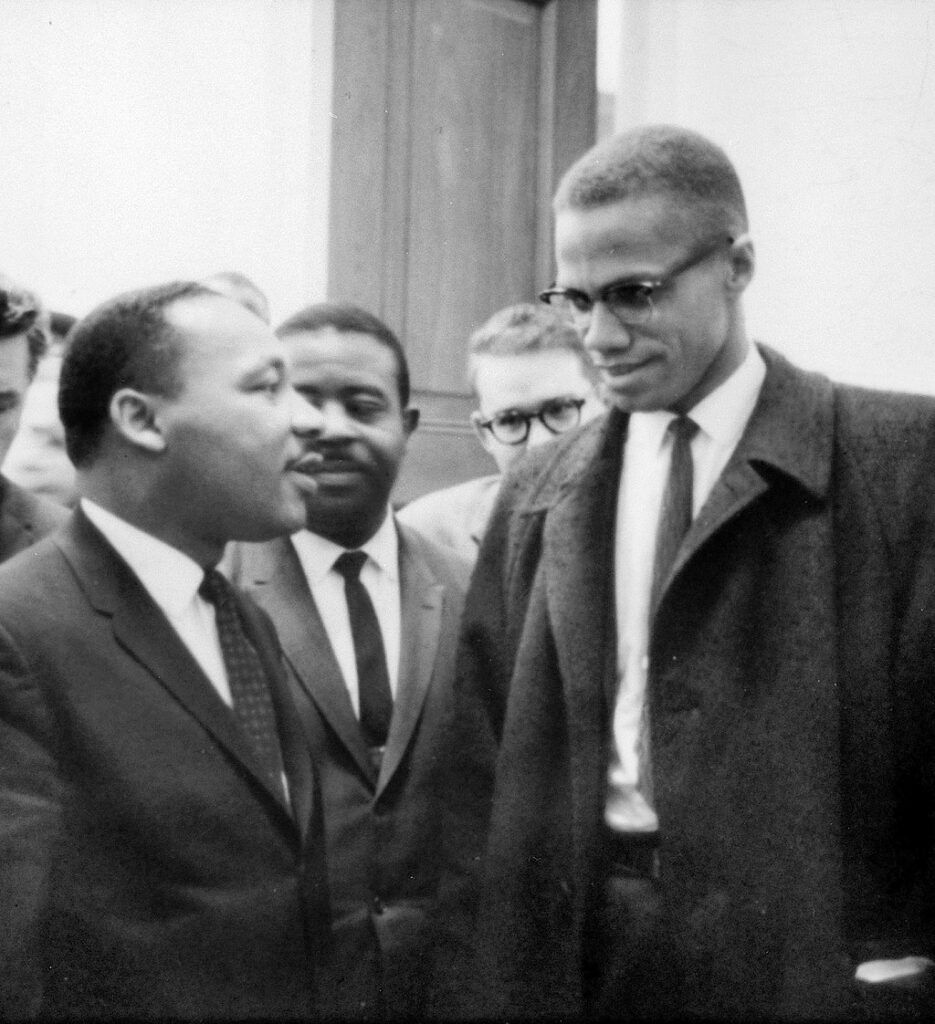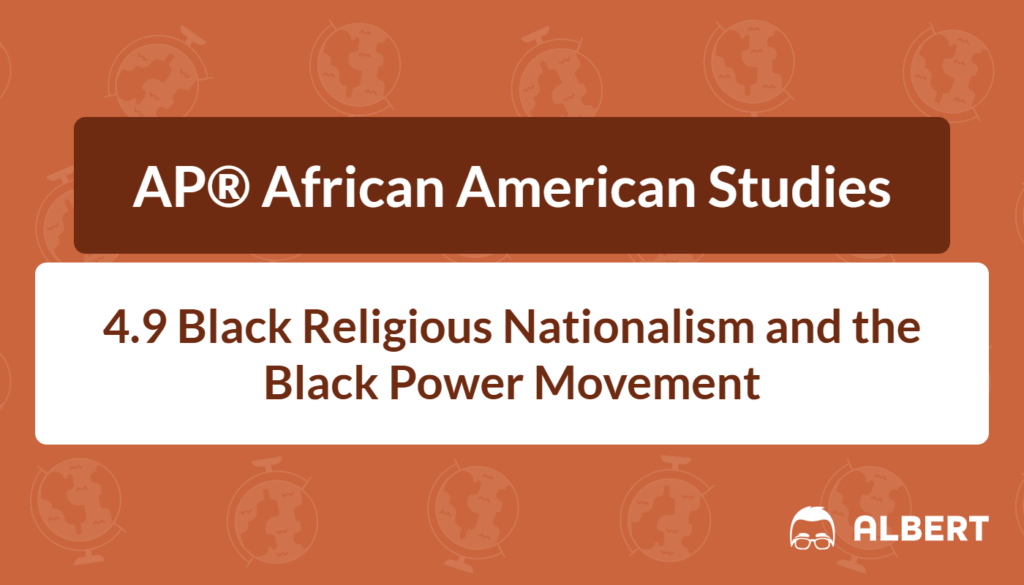What We Review
Introduction
Black Religious Nationalism and the Black Power Movement played a central role in shaping African American activism during the mid-1900s. Both were driven by the need for cultural pride, self-determination, and dignity in the face of injustice. Because these movements influenced the course of United States history, they are essential for understanding key shifts in Black consciousness and strategies for liberation.
These topics are particularly significant for AP® African American Studies. They reveal how African Americans combined faith, identity, and political action to create new forms of empowerment. Moreover, they highlight the transition from civil rights tactics centered on nonviolence and integration to more assertive approaches that included self-defense and economic independence. This article will guide readers through the origins of the Nation of Islam, explain how the Black Power movement emerged, and examine Malcolm X’s transformative contributions.
Understanding the Nation of Islam
Definition and Origins
The Nation of Islam (NOI) began in Detroit in 1930. It combined devotion to Allah and study of the Qur’an with Black Nationalist ideas. Therefore, its beliefs merged traditional Islamic practices with a focus on celebrating Black identity. The founder, Wallace D. Fard, aimed to empower African Americans by emphasizing their worth, history, and self-sufficiency.
Elijah Muhammad led the NOI from 1934, guiding it from its Chicago headquarters. Under his leadership, the organization expanded its influence. Many followers took pride in having religious teachings that addressed their specific struggles in America. Because the NOI stressed independence, its members promoted self-reliance in family life, business, politics, and culture.
Key Figures
Elijah Muhammad stands out as the most recognized leader of the Nation of Islam. He built on the early foundation laid by Wallace D. Fard and encouraged a new generation of believers. Additionally, he promoted practices that distinguished the NOI from other groups. These included the use of the letter “X” to replace last names given by enslavers.
Beliefs and Practices
- Devotion to Allah and the Qur’an
- Belief in African American self-determination
- Abandonment of surnames inherited from slavery
- Adoption of new names that reflect individual and collective identities
Exploring the Creation of Muslim Identities
- Followers were encouraged to reject the names their enslavers had given.
- Many members used “X” as a symbol to mark this break from the past.
- Eventually, some believers received Arabic or Muslim names in recognition of their commitment.
These steps helped create a shared identity rooted in faith and cultural pride. Therefore, the Nation of Islam promoted more than just religious belonging. It offered a blueprint for rebuilding dignity among African Americans.
Transition from Civil Rights to Black Power
Shifts in Strategies
During the early 1960s, many African Americans worked within the Civil Rights Movement, focusing on integration and nonviolent resistance. Martin Luther King Jr. and other leaders believed in changing society through legislation and peaceful protest. However, the rise of violent attacks on civil rights activists led more people to question whether these strategies were enough to protect Black communities.
Next came increasing support for alternative methods that placed control in Black communities’ own hands. Disillusionment with slow progress and persistent discrimination pushed some activists to look for new struggles that went beyond traditional civil rights platforms.
Introduction to Black Power
Black Power emerged as a powerful call for African Americans to determine their own destiny. This approach prioritized self-defense, economic self-sufficiency, and cultural pride rather than waiting for acceptance from existing power structures. Because it emphasized dignity, resilience, and group cohesion, Black Power immediately resonated with those seeking a more assertive stand in the ongoing fight for equality.
The Shift in Strategy
- The Civil Rights Movement initially focused on integration and legal victories.
- Episodes of violence against African Americans began to shake confidence in nonviolence alone.
- Black Power gained attention by stressing self-determination, unity, and preparedness to fight back if necessary.
This transition did not mean the absence of peaceful methods. Rather, it introduced the possibility that self-defense could be necessary when rights were not protected by law enforcement or the broader society.
Malcolm X: A Revolutionary Figure
Role in the Black Power Movement
Malcolm X, a minister in the Nation of Islam, became synonymous with the ideals of Black autonomy and pride. He encouraged African Americans to build independent communities, highlighting the importance of having control over their politics, education, and economics. Therefore, his influence was far-reaching, shaping conversations around civil rights and deepening the philosophy that fueled Black Power.
Because of his powerful speaking style, Malcolm X captured national attention. He argued that African Americans needed to defend themselves if the government failed to provide protection. Moreover, he emphasized the rights promised in the Constitution, including the Second Amendment, as a means for oppressed groups to safeguard their lives and futures.

Evolution of Malcolm X’s Ideas
Over time, Malcolm X’s outlook broadened. After leaving the Nation of Islam, he embraced orthodox Islam, traveled abroad, and promoted pan-African unity. He realized that racism had global roots and was not limited to one country. Consequently, he spent his final years working to connect Africans and their descendants worldwide in a shared struggle for dignity and human rights.
Malcolm X’s Impact
- He first emphasized Black Nationalism and criticized the status quo in the United States.
- He then expanded his views to include the global fight against injustice, seeking alliances across different nations.
- Through his messages on self-defense, empowerment, and cultural awareness, Malcolm X inspired future civil rights and Black Power leaders.
Key Concepts and Beliefs of Black Power
Cultural Pride
Black Power advocates promoted vigorous pride in African heritage. They encouraged African Americans to learn about African civilizations, traditions, and achievements. Therefore, cultural pride united Black communities in a shared legacy of resilience and creativity. This celebration of African culture also boosted confidence among individuals long denied positive representations of their heritage.
Self-Defense and Armed Resistance
Malcolm X famously challenged the idea that demonstrators should remain passive if attacked. He saw self-defense as an essential human right. Because of frequent acts of violence against Black neighborhoods, he believed communities should be prepared to protect themselves. Although this stance was controversial, it showed the seriousness with which Black Power activists approached issues of safety and respect.
Community Building
- Creating independent businesses and schools
- Developing strong social networks
- Supporting local political candidates
These efforts aimed to break away from dependence on outside aid. Consequently, they fostered teamwork and collective determination, core values that helped sustain the Black Power movement over the years.
Example: The Significance of Self-Defense
- Legal ownership of firearms became a way to secure basic safety.
- The community took greater responsibility for its members, discouraging intimidation from hostile groups.
- Organized efforts, such as neighborhood patrols, fortified a sense of solidarity and mutual protection.
Because of these strategies, Black Power helped many African Americans feel more confident in asserting their rights and demanding fair treatment.
Conclusion
Black Religious Nationalism and the Black Power Movement reshaped African American activism in profound ways. The Nation of Islam’s focus on cultural identity and self-sufficiency offered a model for reclaiming dignity in a hostile environment. Meanwhile, the Black Power movement emerged in response to frustration with the slow pace of integration and ongoing violence. Both prompted African Americans to explore new avenues for change, including independence, self-defense, and international alliances.
Understanding these movements illuminates how African Americans navigated a complex period in U.S. history, transitioning from civil rights to Black Power. Because of key figures like Malcolm X and Elijah Muhammad, new approaches to justice and empowerment took root. These philosophies continue to influence discussions around race, autonomy, and equality today.
Key Reference Sources
Below are specific sources that provide deeper insight into Black Religious Nationalism, the Nation of Islam, and the Black Power Movement. Each reflects a unique perspective on the historical context, relevance, and impact of these pivotal moments.
1. “The Ballot or the Bullet” by Malcolm X, 1964
- In this speech, Malcolm X encouraged African Americans to use both electoral power and, if necessary, the threat of self-defense to secure their rights. Delivered during a time of intense civil rights struggles, it underscored the right to vote as well as a plan to protect oneself when the government failed to act.
2. Malcolm X and Martin Luther King Jr. After Press Conference at United States Capitol, 1964 (see image above)
- This image highlights a rare meeting between two major figures in African American activism. Although Malcolm X and Martin Luther King Jr. had differing approaches, this moment captured their shared commitment to freedom.
3. Muhammad Speaks Newspaper Salesmen, 1965
- Muhammad Speaks was the official newspaper of the Nation of Islam. Seeing vendors of this publication across the country illustrated the NOI’s broad influence. The newspaper promoted the group’s message of religious devotion, cultural pride, and resistance to oppression.
4. Elijah Muhammad Addressing Black Muslims at Convention, 1966
- This photograph showcases Elijah Muhammad’s central role within the Nation of Islam. He used events like this to reinforce the NOI’s teachings on moral behavior, self-determination, and racial uplift. Because of his leadership, the NOI shaped public debates around Black identity, independence, and nationhood.
These sources collectively reveal how faith, political activism, and the demand for self-defense intersected during the mid-20th century. They also emphasize the ongoing struggle for safety and dignity, which remains a key part of African American history.
Quick Reference Vocabulary Chart
| Term | Definition |
| Nation of Islam (NOI) | A religious and political movement founded in 1930, combining Islamic beliefs and Black Nationalist ideology |
| Elijah Muhammad | Leader of the NOI from 1934 who promoted Black identity and cultural pride |
| Black Power | A movement advocating for self-determination, cultural pride, and the right to self-defense among African Americans |
| Malcolm X | A major figure in the Black Power Movement known for his advocacy of Black autonomy and global human rights, evolving from NOI teachings to embrace orthodox Islam and worldwide connections |
| Cultural Pride | The recognition and celebration of African American history, culture, and contributions. Often tied to a sense of self-worth and community building |
| Self-Defense | The right to protect oneself against violence or oppression, generally emphasized in the Black Power Movement, including Malcolm X’s arguments for armed self-defense when the state failed to protect African American lives |
These terms provide a helpful guide to significant ideas, figures, and movements within Black Religious Nationalism and the Black Power era. Each concept influenced how African Americans approached social, economic, and political advancement during the mid-20th century.
Sharpen Your Skills for AP® African American Studies
Are you preparing for the AP® African American Studies test? We’ve got you covered! Try our review articles designed to help you confidently tackle real-world AP® African American Studies problems. You’ll find everything you need to succeed, from quick tips to detailed strategies. Start exploring now!
Need help preparing for your AP® African American Studies exam?
Albert has hundreds of AP® African American Studies practice questions, free response, and full-length practice tests to try out.









